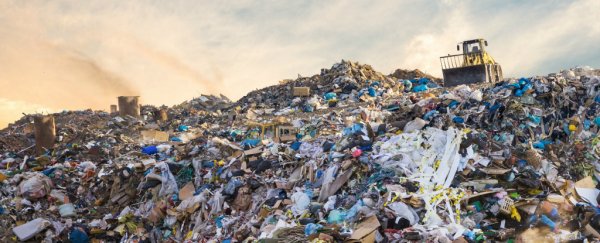Recycling in the United States is piling up at an alarming speed and no one knows where to put it.
Up until recently, that was China's problem. For years, the US offloaded nearly 4,000 shipping containers full of recyclables on China's shoulders every day.
But China is sick of being the world's recycling bin, and by 2020, the country wants no more foreign waste. In a recent push to fight local pollution, the Chinese government has enforced a new policy that bans the import of 24 types of solid waste, including most forms of paper and plastic.
The changes came into effect at the start of this year, and ever since, recycling businesses in the US have been scrambling.
Each year, the US recycles roughly 66 millions tons of material, and about a third of that is ultimately sold overseas, mostly to China. Last year, for instance, China bought up more than half of the scrap materials exported by the US.
But where will it all go now that China has said "enough"? The reality is, there are few places around the world that can take on that much recycling.
And it's not just the US that is looking for somewhere to offload the trash. Recyclers in Canada, Australia, Britain, and some parts of Europe have all been affected by China's new policy.
Since 1992, China and Hong Kong have taken 72 percent of all plastic waste in the world. Finding a replacement for that kind of contribution will not be easy.
"There is no single and frankly, probably not even a group of countries, that can take in the volume that China used to take," Adina Renee Adler of the Washington-based Institute of Scrap Recycling Industries told phys.org.
It's the truth. Not even Indonesia, Vietnam or India are capable of taking on what China once did. By 2030, a 2018 study estimates that the Chinese policy will ultimately displace 111 million metric tons of plastic waste.
"It's hard to predict what will happen to the plastic waste that was once destined for Chinese processing facilities," says co-author Jambeck, who researchers plastic waste in the ocean at the University of Georgia.
"Some of it could be diverted to other countries, but most of them lack the infrastructure to manage their own waste let alone the waste produced by the rest of the world."
In the US, the recycling is already starting to pile up. In fact, some facilities are so overrun that they have stopped sorting through plastic and paper altogether, and are sending it all to the landfill instead.
And this is just the start of the problem. To make their 2020 goal, China is taking it up a notch.
In April this year, the country announced it would be banning a further 32 types of scrap metals for import to recycling plants. Each of these bans will reportedly be introduced incrementally, with half of them starting next year and the rest taking effect in 2020.
If the US and other countries around the world cannot figure out a way to recycle their waste domestically, the problem will only grow more and more insurmountable. And soon, there might be no reason to use the recycling bin at all.
"Without bold new ideas and system-wide changes, even the relatively low current recycling rates will no longer be met, and our previously recycled materials could now end up in landfills," Jambeck says.
